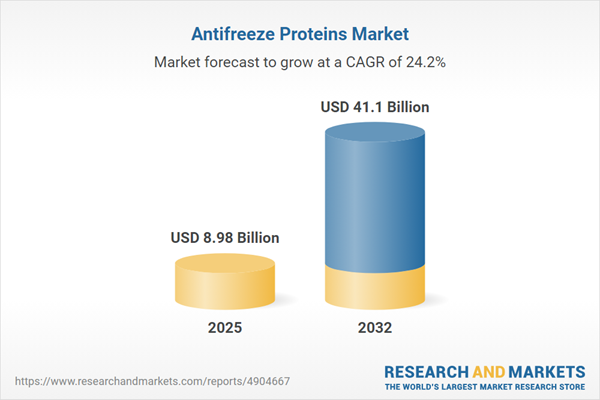Speak directly to the analyst to clarify any post sales queries you may have.
The antifreeze proteins market is experiencing rapid transformation, as industries pivot toward biologically driven solutions for enhanced cold chain management, product resilience, and sustainability. This shift is creating new opportunities for decision-makers to leverage the unique benefits of antifreeze proteins across critical applications.
Market Snapshot: Antifreeze Proteins Market Expansion and Growth Drivers
The Antifreeze Proteins Market grew from USD 7.24 billion in 2024 to USD 8.98 billion in 2025. It is expected to continue growing at a CAGR of 24.23%, reaching USD 41.10 billion by 2032. This strong upward trajectory is driven by technological advancements in protein engineering, increasing complexity in supply chains, and mounting demand for innovative frost protection and preservation solutions across agriculture, healthcare, and food safety sectors. Senior leaders in biotechnology and procurement are facing evolving challenges in sourcing, compliance, and partnerships, underscoring the need for strategic, data-informed decisions in this dynamic environment.
Scope & Comprehensive Segmentation
This report delivers an in-depth analysis of the primary and secondary segments, equipping industry executives with complete visibility into regions, product types, production technologies, and end users shaping the competitive landscape.
- Type: Type I, Type II, Type III, Type IV, Type V
- Source: Animal, Fish, Microbial, Plant, Synthetic
- Technology: Natural Extraction, Recombinant Expression
- Form: Liquid, Powder
- Application: Agriculture (Crop Protection, Pesticide Formulation, Seed Coating), Cosmetics (Hair Care, Personal Care, Skin Care), Cryopreservation (Cell Culture, Organ, Semen, Tissue Preservation), Frozen Food (Confectionery, Ice Cream, Meat, Seafood), Pharmaceuticals (Cold Chain Transport, Drug Formulation, Vaccine Stabilization)
- Regional Coverage: Americas (United States, Canada, Mexico, Brazil, Argentina, Chile, Colombia, Peru), Europe, Middle East & Africa (UK, Germany, France, Russia, Italy, Spain, Netherlands, Sweden, Poland, Switzerland, UAE, Saudi Arabia, Qatar, Turkey, Israel, South Africa, Nigeria, Egypt, Kenya), Asia-Pacific (China, India, Japan, Australia, South Korea, Indonesia, Thailand, Malaysia, Singapore, Taiwan)
- Companies Profiled: Thermo Fisher Scientific Inc., Merck KGaA, Danaher Corporation, Bio-Techne Corporation, Abcam plc, Enzo Life Sciences, Inc., ArcticZymes Technologies ASA, Lonza Group AG, Promega Corporation, GenScript Biotech Corporation
Key Takeaways for Senior Decision-Makers
- Antifreeze proteins offer natural, energy-efficient alternatives to conventional agents, helping industries efficiently manage product stability at subzero temperatures and improve sustainability.
- Recent developments in synthetic biology and molecular engineering enable bespoke antifreeze proteins, expanding possibilities for sensitive agricultural, biomedical, and food applications.
- The shift toward recombinant production is bridging the gap from lab prototypes to cost-effective, scalable commercial products, supporting rapid market penetration and diverse customer needs.
- Collaborations and alliances between research bodies, industrial biotechnology firms, and application leaders are accelerating innovation adoption and driving sector-wide efficiency gains.
- Flexible sourcing strategies, such as embracing multiple biological and synthetic extraction routes, are safeguarding supply chains against raw material or regulatory disruptions and enabling agile operations.
Tariff Impact: Navigating the Regulatory Environment in 2025
With the introduction of revised tariffs in the United States for key antifreeze protein inputs and finished products in 2025, producers and buyers have adapted rapidly. Companies have reduced exposure to high-tariff markets, invested in local manufacturing, and pursued alternative sourcing. Streamlined regulatory pathways and domestic production incentives have further strengthened resilience, enabling uninterrupted supply for essential sectors such as agriculture, cold chain, and life sciences.
Robust Methodology & Data Sources
The foundation of this analysis is a multi-tiered research process integrating expert interviews, secondary literature reviews, and patent analytics. Market mapping and frequent data validation ensure that every trend, regulatory update, and innovation trajectory reflected is based on the most recent and relevant evidence.
Why This Report Matters to Antifreeze Proteins Market Leaders
- Gain strategic clarity on key growth drivers, emerging application areas, and sustainable production methods for antifreeze proteins.
- Identify actionable opportunities to strengthen global supply chain resilience, enhance product portfolios, and streamline regulatory compliance amid evolving trade and sustainability pressures.
- Benchmark your organizational strategy against top-tier players and understand partnership opportunities crucial for market expansion.
Conclusion
Antifreeze proteins are transforming how industries approach thermal management, product stability, and sustainability. By leveraging this research, senior leaders can align operational priorities with evolving market realities and seize opportunities for growth in a complex, competitive landscape.
Additional Product Information:
- Purchase of this report includes 1 year online access with quarterly updates.
- This report can be updated on request. Please contact our Customer Experience team using the Ask a Question widget on our website.
Table of Contents
3. Executive Summary
4. Market Overview
7. Cumulative Impact of Artificial Intelligence 2025
Companies Mentioned
The companies profiled in this Antifreeze Proteins market report include:- Thermo Fisher Scientific Inc.
- Merck KGaA
- Danaher Corporation
- Bio-Techne Corporation
- Abcam plc
- Enzo Life Sciences, Inc.
- ArcticZymes Technologies ASA
- Lonza Group AG
- Promega Corporation
- GenScript Biotech Corporation
Table Information
| Report Attribute | Details |
|---|---|
| No. of Pages | 183 |
| Published | October 2025 |
| Forecast Period | 2025 - 2032 |
| Estimated Market Value ( USD | $ 8.98 Billion |
| Forecasted Market Value ( USD | $ 41.1 Billion |
| Compound Annual Growth Rate | 24.2% |
| Regions Covered | Global |
| No. of Companies Mentioned | 11 |









